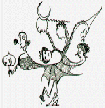 |
ANTIQUE BOXES
at the Sign of the Hygra
2 Middleton Road
London E8 4BL
Tel: 00 44 (0)20 7254 7074
email: boxes@hygra.com |
Antique Boxes in English Society
1760 -1900
by ANTIGONE
Tea Caddies and Tea
|
|
| A Regency Neoclassical Rosewood Tea Chest with Brass inlay Circa 1810. |
A Regency neoclassical tea chest of oblong form with a gadrooned
edge to the top, brass inlay to the front and top, embossed gilt
brass side handles, and embossed brass feet.
Earlier pieces featuring brass inlaid ornament have an
unrivalled purity of design. The brass motifs are well separated
and is of stylized and restrained form. The decoration and form
are classical
rather than naturalistic.
It measures 12 inches wide by
6 inches deep and it is 7 inches high including feet:
30cm wide by 15cm deep by 18cm
high.
|  |
|
|
|
|
|
|
|
|
|
|
|
|
|
|
|
|
|
|
|

|
Detail of the top:
the brass inlay is symmetrical and inlaid into a well-figured panel
of rosewood which is crossbanded with rosewood and framed with
gadrooning.
The top design is laid out with symmetry the separate motifs
around a central element. The style and the form are very different to the brass inlay
work which was more usual only a few years later. |
|
|
|
|
|
|
|
|
|

|
Inside the chest are two lift-out lidded canisters and a cut glass
bowl. The lid is lined with velvet. This is the classic
form for a three compartment tea chest. There is a central cut crystal
bowl flanked by two hinge lidded lift out canisters.
It is interesting to compare it to a chest from the 1790's:
Hygra: A Harewood Three Compartment Tea Caddy circa 1790. |
|
|
|
|
|
 |
The lift out canisters retain much of their original lead.
The lids have a continuous hinge are of mahogany construction and
have their lids veneered with rosewood crossbanded with rosewood.
|
|
|

|
The heavy cut crystal bowl.
The bowl is a particularly beautiful example and original to the
chest.
|
|
|
|
|
|

|
|
|
|












